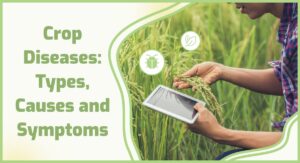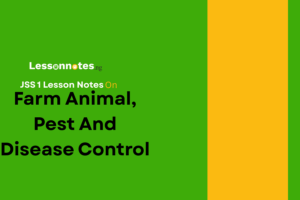Diseases In Crops SS2 Agricultural Science Lesson Note
Download Lesson NoteTopic: Diseases In Crops

MEANING AND CAUSES OF DISEASE
A crop is a plant cultivated by man for a specific purpose. A plant disease is a deviation of the plant from the normal state of health, presenting outward visible signs. Diseases are caused by pathogens and are enhanced by some physiological factors.
CAUSES OF DISEASE
Plant diseases are caused by pathogens. Pathogens are disease-causing organisms which pass through a regular cycle of development and reproduction.
Examples of pathogens that cause plant disease are viruses, bacteria, fungi, parasitic worms and rarely protozoa. Some of these pathogens are carried by vectors and other agents.
Physiological factors such as nutrient deficiency in the soil, heat, presence of inorganic salts in the soil and soil moisture content have a major role to play in influencing plant susceptibility to diseases.
SELECTED DISEASE OF CROPS
| NAME | CAUSAL ORGANISM | METHOD OF TRANSMISSION | SYMPTOMS AND ECONOMIC IMPORTANCE | PREVENTION AND CONTROL MEASURES |
| Maize smut | Fungus (Ustilago ) | Fungus spores deposited on fruits | i. Reduced yield
ii. Galls on ears, leaves and tarsals which later turn black |
i. Destroy diseased plants.
ii. Use resistant varieties. iii. Seed treatment. |
| Rice blight | Fungus (Piricularia oryzae) | Airborne spores on leaves | i. Small longitudinal red spots on leaves which turn grey or brown
ii. Reduced yield |
i. Use clean seeds
ii. Avoid heavy use of nitrogen fertilizers. iii. Use resistant varieties |
| Cercospora
A leaf spot of cowpea |
Fungus | Through Wind | i. Reddish brown spots on leaves
ii. Lesions on leaves iii. Chlorosis |
i. Dropping or falling leaves.
ii. Spray with fungicides iii. Crop rotation iv. Plant resistant varieties. |
| Maize rust | Fungus (Puccinia polysora) | Airborne spores deposited on leaves | i. Red spots on leaves.
ii. Reduced yield |
i. Death of crop.
ii. Early planting iii. Crop rotation iv. Use resistant varieties. |
| Rosette disease of groundnut | Virus | By piercing and sucking insects (Aphid) | i. Yellow leaves with mosaic mottling.
ii. Stunted plant with curled leaves. iii. Wilting and death of plants. iv. Shortening of the internodes. |
i. Early planting
ii. Crop rotation iii. Use insecticides iv. Uproot and burn infected plants. v. Use resistant variety. |
| Cassava mosaic | Virus | i. Through piercing and sucking insects (whitefly)
(Bemisia nigerensis) ii. Infected plant cutting |
i. Mottling of leaves or leaf curl
ii. Distortion of leaves and stems. iii. Vein clearing Stunted growth iv. Development of yellowish-pale areas alternating with green patches on the leaves or mosaic patterns on the leaves |
i. Use resistant varieties
ii. Uproot and burn infected plant iii. Spray with insecticide to kill vector iv. Use disease-free stem cuttings v. Farm sanitation. |
| Leaf blight of cassava | Bacterium
Xanthomonas manholes |
i. Infected cuttings
ii. Rain splashing iii. Insects iv. Tools |
i. Blighting of leaves
ii. Wilting of plant iii. Falling off of leaves iv. Reduced yield v. Canker of stem vi. Die-back of stem |
i. Use resistant varieties
ii. Use disease-free cuttings iii. Early planting iv. Practice crop rotation |
| Cocoa black pod disease | Fungus Phytophthora | i. Rain splash
ii. Insects |
i. Brown spots on the pod
ii. Rotting of pods iii. Entire pod turns black iv. Low yield |
i. Remove and destroy infected pods
ii. Regular weeding iii. Spray with fungicides eg Bordeaux mixture iv. Avoid overcrowding of cocoa plants. |
| Coffee leaf rust | Fungus | i. By wind
ii. By rain splash |
i. Yellow or brown spot on leaves
ii. Orange powdery mass on the leaf iii. Reduction in yield iv. Dropping of leaves |
i. Plant seeds from healthy plants
ii. Use resistant varieties. iii. Spray with copper fungicides. |
| Black arm (bacterial blight of cotton) | Bacterium | i. Through leaves
ii. Stems near the ground iii. Angular spot on leaves iv. Boll rot |
i. Exudates from affected leaves
ii. Retarded growth and death of plants. |
i. Seed dressing
ii. Uproot and burn infected plants |
| Root-knot of tomatoes/okra | Nematodes | i. Nematodes in soil
ii. Knotting or galling of roots |
i. Retarded growth
ii. Early death of the plant Reduction in yield |
i. Soil sterilization
ii. Crop rotation iii. Use resistant varieties iv. Uproot and burn infected plants |
| Damping off disease of okra | Fungus | Infected soil | i. Retarded growth
ii. Cells become waterlogged iii. Gradual wilting of plant iv. Death of plant |
i. Spray with copper fungicide
ii. Use resistant varieties iii. Sterilization of soil |
| Onion twister disease | Fungus | i. Infected soil
ii. Water splash iii. Infected bulb |
i. Twisting of leaves
ii. Gray patches on leaves iii. Reduction in yield iv. Death of plant |
i. Crop rotation
ii. Use resistant varieties iii. Spray with fungicides iv. Early planting |
| Stored produce mold fungicides | Fungus | i. Infected seeds or fruits.
ii. High humidity iii. By Soil |
i. Black mould on seeds and fruits
ii. Pungent smell. iii. Sour taste iv. Decay of seeds and fruits in store. |
i. Proper drying of seed before storage
ii. Spray with iii. Maintain low humidity in store iv. Remove contaminated seeds before storage. |






















